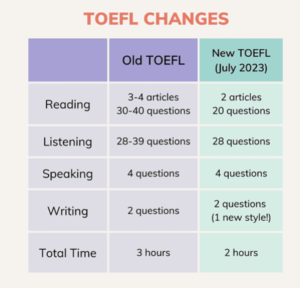
Updated TOEFL Format Guidelines for the 2023 Changes
TOEFL, or Test of English as a Foreign Language, tests non-native speakers’ ability to use and understand North American English as it is written, spoken, heard, and understood in college and university contexts. You can retake the test only three days after taking the first TOEFL test. The TOEFL now the exam has:
1) Fewer questions to make the exam shorter by 30 minutes, and
2) An extra style of score reporting called MyBest™ scores.

The TOEFL Reading Section
You will read three to four passages in this part and respond to ten questions about each one. The quantity of accurate reading comprehension responses determines how well the section scores.
The reading section of TOEFL iBT tests your ability to comprehend academic texts. It typically consists of 3 – 4 reading passages, each of which is followed by a set of questions for you to answer. You will now answer only 10 questions after each passage instead of 12-14 questions. The duration will now be between 54 – 72 minutes instead of 60 – 80 minutes. The total number of passages has not been changed. No question types have been eliminated.
The TOEFL Listening Section
You will hear lectures and conversations using the college lingo in the listening test part. This component evaluates the test-taker’s comprehension of English-language conversations and lectures. It entails linking and synthesizing information as well as basic comprehension and listening.
The listening section of TOEFL iBT tests your ability to understand spoken dialogues and decipher academic speech. You will now face only 3 – 4 ‘lectures’ instead of 4 – 6. The number of questions per lecture remains unchanged at six per lecture. The duration will now be 41 – 57 minutes instead of 60 – 90 minutes. The total number of ‘conversations’ has not been changed. The number of questions after each ‘conversation’ (five) has also not been changed.
The TOEFL Speaking Section
Your responses must meet the requirements of the specified task with only minimal errors or lapses in order for you to receive the best scores in the Speaking Section. The speaking section of TOEFL iBT tests your ability to communicate effectively in different situations. You will now be doing only 4 tasks instead of 6. The duration will now be 17 minutes instead of 20 minutes. The two question types that have been removed from the test are Speaking Question 1: Personal Preference and Speaking Question 5: Campus Situation. The remaining questions are now numbered 1 to 4.
The TOEFL Writing Section
Each topic in the two essays should be effectively covered. The response should be well-developed, and well-organized, and use pertinent justifications and thorough justifications. The writing section of TOEFL iBT tests your ability to construct clear and meaningful sentences. You will still complete 2 tasks in a duration of 50 minutes.
SUMMARY
- The reading section will be shortened to just two articles, with ten questions each. There will be no change to the content of the articles and the question styles.
- The listening section will be shortened to just 28 questions in total. There will be no change to the content and question styles.
- The speaking section will be the same.
- The writing section will have two questions. The first will be the same integrated writing question as before. The second will be an academic discussion question.
- There will be no break.
- There will be no unscored questions.
- The test will take slightly less than two hours to complete.
SCORES AVAILABILITY
The official TOEFL iBT score will be accessible to you within 6 days of the exam date, and test-takers who choose the Special Home Edition of the TOEFL exam will receive their results within 6 to 10 days after the test date. If a candidate requests a print copy of their score report before taking the exam, it will be mailed to them within 11 days after the test date. The new TOEFL score scale’s scoring system and requirements remain unchanged.


